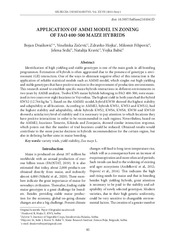Приказ основних података о документу
Application of AMMI model in zoning of FAO 400-500 maize hybrids
| dc.creator | Drašković, Bojan | |
| dc.creator | Zečević, Veselinka | |
| dc.creator | Hojka, Zdravko | |
| dc.creator | Filipović, Milomir | |
| dc.creator | Srdić, Jelena | |
| dc.creator | Kravić, Natalija | |
| dc.creator | Babić, Vojka | |
| dc.date.accessioned | 2021-08-04T12:49:22Z | |
| dc.date.available | 2021-08-04T12:49:22Z | |
| dc.date.issued | 2021 | |
| dc.identifier.issn | 0354-5881 | |
| dc.identifier.uri | http://RIVeC.institut-palanka.rs/handle/123456789/271 | |
| dc.description.abstract | Identification of high yielding and stable genotypes is one of the main goals in all breeding programmes. Estimation of hybrids is often aggravated due to the presence of genotype x environment (GE) interaction. One of the ways to eliminate negative effect of this interaction is the application of reliable statistical models such as AMMI model, which singles out high yielding and stable genotypes that have positive reaction to the improvement of production environments. This research aimed to establish specific maize hybrids interactions in different environments in two years by AMMI analysis. Twelve KWS maize hybrids belonging to FAO 400-500, were examined in two years over eight locations in Vojvodina. The highest yield in both years had the hybrid KWS2 (12.764 kg ha-1). Based on the AMMI1 model, hybrid KWS9 showed the highest stability and adaptability at all locations. According to AMMI2, hybrids KWS1, KWS3 and KWS12, had the highest stability and adaptability, while hybrids KWS2, KWS6, KWS8, KWS9 and KWS10 showed a satisfactory level of stability and it is necessary to pay attention to which locations they have positive interactions in order to be recommended in such regions. Nevertheless, based on the AMMI2, locations Temerin, Kikinda and Zrenjanin, showed similar interaction response, which points out that the number of trial locations could be reduced. Obtained results would contribute to the more precise decision in hybrids recommendation for the certain region, but also in defining further aims in maize breeding. | sr |
| dc.language.iso | en | sr |
| dc.publisher | Belgrade : Serbian Association of Plant Breedings and Seed Producers | sr |
| dc.rights | openAccess | sr |
| dc.rights.uri | https://creativecommons.org/licenses/by-sa/4.0/ | |
| dc.source | Selekcija i semenarstvo | sr |
| dc.subject | variety trials | sr |
| dc.subject | yield stability | sr |
| dc.subject | Zea mays L | sr |
| dc.title | Application of AMMI model in zoning of FAO 400-500 maize hybrids | sr |
| dc.type | article | sr |
| dc.rights.license | BY-SA | sr |
| dc.citation.epage | 49 | |
| dc.citation.issue | 1 | |
| dc.citation.rank | M51 | |
| dc.citation.spage | 41 | |
| dc.citation.volume | 27 | |
| dc.identifier.doi | 10 .5937/SelSem2101041D | |
| dc.identifier.fulltext | http://RIVeC.institut-palanka.rs/bitstream/id/618/0354-58812101041D.pdf | |
| dc.type.version | publishedVersion | sr |


